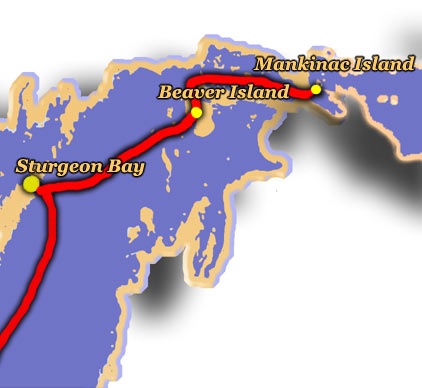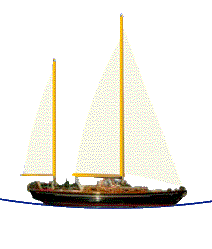



On the morning of August 7th,
we sailed to Mackinac Island, again mostly downwind. We have been lucky in our sailing conditions to date. In route, we passed several large freighters.The Gray's reef lighthouses are impressive standing as lone guardians in the middle of the Lake.
We left Lake Michigan and entered Huron as we went under the Mackinac Bridge. Tacking around cowboy turbo ferries, we passed between the Round Island lighthouse and the Old Mackinac lighthouse and anchored in Mackinac Harbor.
This is a beautiful but tourist filled island. It is unique in that no automobiles are allowed and all transportation is by bicycles and horse drawn carts. The high tech Segway vehicles are specifically prohibited.
Many of the original Victorian hotels and homes have been preserved and are actively utilized. The harbor is overlooked by the Grand Hotel and historic Fort Mackinac.
We have it on good authority from our new little friends Sarah and Suzie that the Butterfly Museum is an excellent place to visit, even though it is not quite as good as the one at Niagara Falls.
The name of the island is from the French interpretation of the original Native American "Turtle Island".
In the dim light of early morning the island begins to stir. The horses are fed and prepared for their day. They are the pulse of the island. The people on this beautiful Great Turtle island decided that they didn't want to have cars and car exhaust on the island and that it is worth the extra work to keep it that way. Hay is delivered to the island and the stables. Blacksmiths pound out the horseshoes. The horses are groomed and saddled and are ready for moving people, baggage and materials around the island. Then, the rhythmic sounds of the horse's hoofs begin clip-clop, clip-clop. There is an organic smell to the island and a cadre of scoopers patrol the island streets.
After spending several days with no autos, but a plethora of bikes and horses, one has to ponder the pros and cons. The use of horses is very labor intensive and not inexpensive. Hay must be grown by local farmers and then shipped to the horses. The horses must be stabled, fed and cared for. Some byproducts of horse use are messy and require disposal. Autos are less messy. However, to fuel autos we must pay international cartels to extract oil, ship it to our land and refine it to gasoline.
Horse byproducts enrich the Mac Island flower gardens, while car byproducts poison our lungs. I am not proposing that horses replace autos everywhere, but it is nice to have this one special place where they do.
v